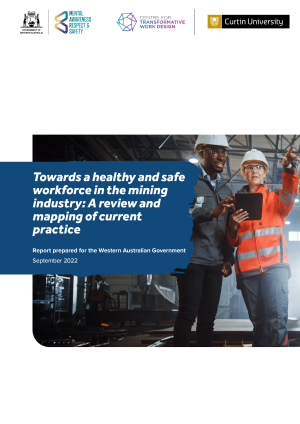Towards a healthy and safe workforce in the mining industry: A review and mapping of current practice
The Mental Awareness, Respect and Safety (MARS) Landmark Study is a four-year research and evaluation project led by ARC Laureate Professor Sharon Parker at the Centre for Transformative Work Design at Curtin University.
The Landmark Study was commissioned by the Western Australian Government to design and implement a research and evaluation project focused on the mining industry.
This preliminary report is the first of four reports submitted to the Western Australian Government as part of the MARS Landmark Study. This report was authored by the Bankwest Curtin Economics Centre as a contribution to the Landmark Study. It presents an assessment of the documented efforts by Australian mining companies to ensure the well-being of employees across three domains: mental health and well-being, physical health and safety, and workplace culture and sexual harassment/assault.
This report provides an assessment of employee well-being in the mining sector and develops an innovate approach to construct measures of employers’ prioritisation of three dimensions of well-being: mental health, physical health and safety, and workplace culture that protects against sexual harassment.
Key findings
Mining workers’ subjective wellbeing
- Compared to 15 years ago, a higher share of mining sector workers report being satisfied with their jobs, but the share of very satisfied workers has gone down.
- At 21.6 per cent, the mining sector has the lowest prevalence of workers who are very satisfied with their job overall compared to workers in other industries.
- Mining is in the top five of industries by the share of workers with excellent or very good physical health.
- The share of mining sector workers reporting low or moderate levels of psychological distress has gone down over the period from 2009 to 2019, while there has been a 6 percentage point increase in the share of workers reporting high distress levels.
Secondary evidence on workplace culture and sexual harassment in the mining sector
- Australia is still lagging behind other countries in preventing and responding to workplace sexual harassment.
- The mining industry is one of the worst five industries in relation to sexual harassment issues with 40 per cent of workers, and 74 per cent of women workers reported having experienced sexual harassment in the last five years.
- Women working within the mining industry frequently face a range of sexual harassment from unconscious sexism and misogyny to assault.
- Major risk factors which contribute to a high incidence of sexual harassment in the mining industry include poor culture, gender inequality and power disparity.





